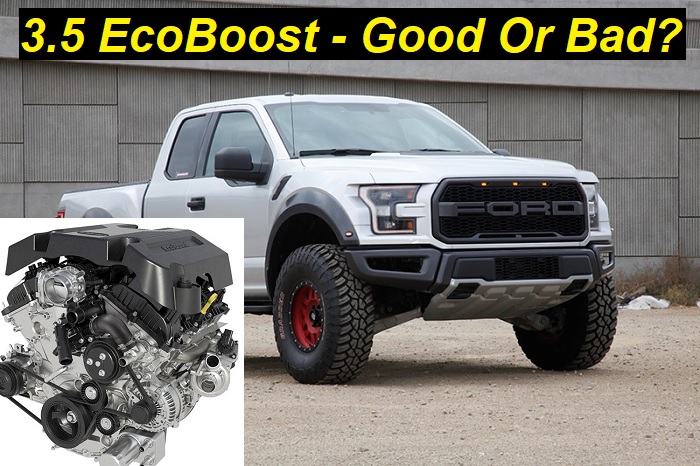New Ford EcoBoost engines are marvelous. They are both long-lasting and efficient. These engines offer high performance and they don't make you visit dealers and car repair shops every other day. But you have to know that there are several EcoBoost engines in Ford's lineup. And not all of them are that good.
Today, we'll be speaking about the Ford 3.5L EcoBoost engine - its problems, longevity, gas mileage, application on different models, etc. And this is going to be informative! We know a lot about this great engine, but we may promise you that all the disadvantages will be reviewed below with our comments on them.

Key features and my opinion about the engine
- Production years:2021-now
- Average lifespan of 3.5L V6 PowerBoost:200,000-240,000 miles
- Fuel supply type:direct injection
- Power range:430 hp
- Fuel efficiency:good
- Engine block material:aluminum
- Engine reliability score:medium
- The most common problems:oil leaks, turbocharger failure, overheating, spark plugs and ignition coils failure.
Something you need to know about the 3.5 EcoBoost
First of all, this engine has got two generations and it has been quite a popular choice for many vehicles. This is a 6-cylinder (V-configuration) engine that was tuned to have different power starting with 320 hp and finishing with 647 horsepower. You can see that the range of power is just insane.
The most powerful version of the 3.5L EcoBoost was used in Ford GT. But the company has used this engine in dozens of models including Explorer, Expedition, Flex, F-150, GT, Police Interceptor, Taurus, Transit, and also in some Lincoln models. The engine has been in production since 2007, in 2015 the second generation was presented.
Here are some facts about the engine you will want to know:
- the engine is often used for tuning because it has an immense opportunity for getting more power;
- the original torque is 350 to 550 pound-feet depending on the model of the vehicle and the year of the engine;
- in most cases, six-speed automatic and ten-speed automatic transmissions were used, but in the GT, they installed a 7-speed dual-clutch transmission with this engine;
- in the second generation, the company risked and arranged a higher compression - 10.5 to 1 instead of 10 to 1, and this was the correct decision;
- of course, cylinder block and head are made of aluminum, the timing system is driven by the chain.
We will not explain to you how the variable camshaft timing works in this engine and whether it uses some special systems for valve positioning. It's a relatively simple engine with a relatively simple construction. Which is actually one of the main advantages. Ford made it to last and it shows wonderful mileage, in many cases.
Also, the fact that the 3.5L EcoBoost has been used in Lincoln MKS, MKT, and Navigator proves that the engine is actually very durable and reliable. The premium brand uses only premium quality parts. But of course, this EcoBoost engine still has some common problems and issues and we'll tell you now about the most interesting ones.
Longevity and maintenance problems
The expected lifespan of the 3.5 EcoBoost engine is around 270 000 miles. It's a lot for a turbocharged engine. But if you look at the main competitors on the market, you will see approximately the same figures. A lot of the turbocharged V6 engines are able to last over 250 000 miles.
But the EcoBoost engine will do it with minimal expenses. You should follow the recommended maintenance guidelines. Be careful with any experiments when servicing this engine. And also keep an eye on the conditions of its work. And it will deliver wonderful longevity without any problems at all.
We should say that the 3.5L EcoBoost can actually live even longer. We've seen F-150 trucks that were fleet cars equipped with these engines. And their mileage was well over 400 000 miles. The engine was still OK, but the owners had to replace the transmissions. So, the mileage depends much on the way you use and service your car.
Regarding maintenance, the engine has no big problems. You can always find and buy parts, you can rely on many dealers and car repair shops. We wouldn't say that servicing this engine is expensive.
Common problems and disadvantages of the engine
One of the problems is the timing chain. If it jumps, you will have to repair the head - most likely, part of the valves will be damaged. That's why it's extremely important to replace the chain at around 100 000 miles or a little later. You may see that the manufacturer doesn't recommend replacing the chain but you should remember this if you want a durable and reliable engine.
Also, many minor problems are known to happen with the 3.5L EcoBoost by Ford. This engine is not bad at all, but we've tried hard and found some problems that are usual for this unit. Please, bear in mind that every engine has its own problems and disadvantages. It doesn't mean that buying a vehicle with this engine is a bad idea.
So, here are some common issues you will have to deal with:
- Intake valves contamination. The construction of the intake manifold and the head is not very brilliant. It leads to some build-up on the valves over time. To have the valves cleaned, you will need to pay quite a lot.
- Ignition coils. The coils start malfunctioning silently and you don't know about it. After some time, they kill the spark plugs and here the real problem starts. One of the cylinders stops working and all the gasoline explodes in the engine or in the catalytic converter.
- Timing chain. We've already told you that replacing a timing chain is important for engine health. But a lot of owners say that the chain starts rattling at about 80 000 miles. You will need to spend a lot of money to get rid of this problem.
- Different leaks. Unfortunately, coolant and oil will sometimes leak from this engine making dirty puddles in your garage or in a parking place. If you see leaks, better go to a dealer or to a repair shop. You will have to deal with it before big problems come.
- Crankshaft ventilation problems. The first generation of the 3.5 EcoBoost had this problem. Once the crankshaft ventilation system was clogged, the oil started coming out of every hole in the engine due to high pressure.
- Software issues. Some versions of the engine (namely 2011-2015) had numerous problems with the software updates. It means that if you have the vehicle of those years, you should check whether you are eligible for a free software update due to recalls.
- Oil burn issues. After the engine hits 100 000 miles, it starts burning some oil. It happens because the piston rings and valve seals start deteriorating. But it doesn't mean that you will have to repair the engine soon. Just don't forget to check the oil level sometimes.
As you see, the 3.5 EcoBoost is not a problem-free engine. But anyway, we should say that we haven't found any critical problems with this engine even when we were searching through the forums. People say the engine is pretty good and even when it hits high mileage marks, it's still OK and can go without any problems.
Again, the fact that some companies use these engines for 400 000 miles is important when we are talking about longevity. This engine is really durable and it doesn't deliver a lot of problems.
Gas mileage on different models
As you see, the engine has been mainly installed on big vehicles like the F-150 or the Flex. These cars are heavy and they don't tend to have very relaxing gas mileage. We could say that nearly all cars equipped with the 3.5 EcoBoost have approximately the same fuel consumption.
We would say that the real consumption is around 24 MPG on the highway and 18 MPG in the city. But if we are talking about high-output engines like the one in Ford GT, their consumption will depend much on the way you press that gas pedal. In most cases, it will be around 13-18 MPG.
It's not that bad if you consider that the vehicles are big and heavy. If you want better gas mileage, you should think about buying a vehicle equipped with 2.7 EcoBoost or any other engine with a smaller displacement.
Final words
The 3.5L EcoBoost is actually a good engine. We haven't found many reviews that would prove different points of view. Most owners love this engine for being really powerful, quite economical, fun to drive, and also extremely reliable. Yes, it is not going to be there for you for half-million miles, but it's still a very durable engine given it's a turbocharged and highly efficient unit. So, we can recommend this engine even if you are looking for a used vehicle.
About the authors
The CarAraC research team is composed of seasoned auto mechanics and automotive industry professionals, including individuals with advanced degrees and certifications in their field. Our team members boast prestigious credentials, reflecting their extensive knowledge and skills. These qualifications include: IMI: Institute of the Motor Industry, ASE-Certified Master Automobile Technicians; Coventry University, Graduate of MA in Automotive Journalism; Politecnico di Torino, Italy, MS Automotive Engineering; Ss. Cyril and Methodius University in Skopje, Mechanical University in Skopje; TOC Automotive College; DHA Suffa University, Department of Mechanical Engineering






Add comment